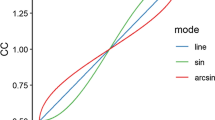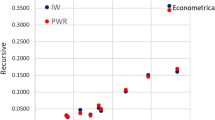Abstract
An abstract construction for general weighted impact factors is introduced. We show that the classical weighted impact factors are particular cases of our model, but it can also be used for defining new impact measuring tools for other sources of information—as repositories of datasets—providing the mathematical support for a new family of altmetrics. Our aim is to show the main mathematical properties of this class of impact measuring tools, that hold as consequences of their mathematical structure and does not depend on the definition of any given index nowadays in use. In order to show the power of our approach in a well-known setting, we apply our construction to analyze the stability of the ordering induced in a list of journals by the 2-year impact factor (\(\hbox {IF}_2\)). We study the change of this ordering when the criterium to define it is given by the numerical value of a new weighted impact factor, in which \(\hbox {IF}_2\) is used for defining the weights. We prove that, if we assume that the weight associated to a citing journal increases with its \(\hbox {IF}_2\), then the ordering given in the list by the new weighted impact factor coincides with the order defined by the \(\hbox {IF}_2\). We give a quantitative bound for the errors committed. We also show two examples of weighted impact factors defined by weights associated to the prestige of the citing journal for the fields of MATHEMATICS and MEDICINE, GENERAL AND INTERNAL, checking if they satisfy the “increasing behavior” mentioned above.





Similar content being viewed by others
References
Ahlgren, P., & Waltman, L. (2014). The correlation between citation-based and expert-based assessments of publication channels: SNIP and SJR vs. Norwegian quality assessments. Journal of Informetrics, 8, 985–996.
Aleixandre Benavent, R., Valderrama Zurián, J. C., & González Alcaide, G. (2007). Scientific journals impact factor: Limitations and alternative indicators. El Profesional de la Información, 16(1), 4–11.
Altmann, K. G., & Gorman, G. E. (1998). The usefulness of impact factor in serial selection: A rank and mean analysis using ecology journals. Library Acquisitions-Practise and Theory, 22, 147–159.
Arnold, D. N., & Fowler, K. K. (2011). Nefarious numbers. Notices of the American Mathematical Society, 58(3), 434–437.
Beliakov, G., & James, S. (2012). Using linear programming for weights identification of generalized bonferroni means in R. In: Proceedings of MDAI 2012 modeling decisions for artificial intelligence. Lecture Notes in Computer Science, Vol. 7647, pp. 35–44.
Beliakov, G., & James, S. (2011). Citation-based journal ranks: The use of fuzzy measures. Fuzzy Sets and Systems, 167, 101–119.
Buela-Casal, G. (2003). Evaluating quality of articles and scientific journals. Proposal of weighted impact factor and a quality index. Psicothema, 15(1), 23–25.
Dorta-Gonzalez, P., & Dorta-Gonzalez, M. I. (2013). Comparing journals from different fields of science and social science through a JCR subject categories normalized impact factor. Scientometrics, 95(2), 645–672.
Dorta-Gonzalez, P., Dorta-Gonzalez, M. I., Santos-Penate, D. R., & Suarez-Vega, R. (2014). Journal topic citation potential and between-field comparisons: The topic normalized impact factor. Journal of Informetrics, 8(2), 406–418.
Egghe, L., & Rousseau, R. (2002). A general frame-work for relative impact indicators. Canadian Journal of Information and Library Science, 27(1), 29–48.
Gagolewski, M., & Mesiar, R. (2014). Monotone measures and universal integrals in a uniform framework for the scientific impact assessment problem. Information Sciences, 263, 166–174.
Garfield, E. (2006). The history and meaning of the journal impact factor. JAMA, 295(1), 90–93.
Habibzadeh, F., & Yadollahie, M. (2008). Journal weighted impact factor: A proposal. Journal of Informetrics, 2(2), 164–172.
Klement, E., Mesiar, R., & Pap, E. (2010). A universal integral as common frame for Choquet and Sugeno integral. IEEE Transaction on Fuzzy System, 18, 178–187.
Leydesdorff, L., & Opthof, T. (2010). Scopus’s source normalized impact per paper (SNIP) versus a journal impact factor based on fractional counting of citations. Journal of the American Society for Information Science and Technology, 61, 2365–2369.
Li, Y. R., Radicchi, F., Castellano, C., & Ruiz-Castillo, J. (2013). Quantitative evaluation of alternative field normalization procedures. Journal of Informetrics, 7(3), 746–755.
Moed, H. F. (2010). Measuring contextual citation impact of scientific journals. Journal of Informetrics, 4, 265–277.
NISO. (2014). Alternative metrics initiative phase 1. White paper. http://www.niso.org/apps/group-public/download.php/13809/Altmetrics-project-phase1-white-paper
Owlia, P., Vasei, M., Goliaei, B., & Nassiri, I. (2011). Normalized impact factor (NIF): An adjusted method for calculating the citation rate of biomedical journals. Journal of Biomedical Informatics, 44(2), 216–220.
Pinski, G., & Narin, F. (1976). Citation influence for journal aggregates of scientific publications: Theory, with application to the literature of physics. Information Processing and Management, 12, 297–312.
Pinto, A. C., & Andrade, J. B. (1999). Impact factor of scientific journals: What is the meaning of this parameter? Quimica Nova, 22, 448–453.
Raghunathan, M. S., & Srinivas, V. (2001). Significance of impact factor with regard to mathematics journals. Current Science, 80(5), 605.
Ruiz Castillo, J., & Waltman, L. (2015). Field-normalized citation impact indicators using algorithmically constructed classification systems of science. Journal of Informetrics, 9, 102–117.
Saha, S., Saint, S., & Christakis, D. A. (2003). Impact factor: A valid measure of journal quality? Journal of the Medical Library Association, 91, 42–46.
Torra, V., & Narukawa, Y. (2008). The h-index and the number of citations: Two fuzzy integrals. IEEE Transaction on Fuzzy System, 16, 795–797.
Torres-Salinas, D., & Jimenez-Contreras, E. (2010). Introduction and comparative study of the new scientific journals citation indicators in journal citation reports and scopus. El Profesional de la Información, 19, 201–207.
Waltman, L., & van Eck, N. J. (2008). Some comments on the journal weighted impact factor proposed by Habibzadeh and Yadollahie. Journal of Informetrics, 2(4), 369–372.
Waltman, L., van Eck, N. J., van Leeuwen, T. N., & Visser, M. S. (2013). Some modifications to the SNIP journal impact indicator. Journal of Informetrics, 7, 272–285.
Zitt, M. (2011). Behind citing-side normalization of citations: some properties of the journal impact factor. Scientometrics, 89, 329–344.
Zitt, M., & Small, H. (2008). Modifying the journal impact factor by fractional citation weighting: The audience factor. Journal of the American Society for Information Science and Technology, 59, 1856–1860.
Zyczkowski, K. (2010). Citation graph, weighted impact factors and performance indices. Scientometrics, 85(1), 301–315.
Acknowledgments
The authors want to thank the comments and corrections of the referee, that have improved the contents and presentation of the paper.
Author information
Authors and Affiliations
Corresponding author
Rights and permissions
About this article
Cite this article
Ferrer-Sapena, A., Sánchez-Pérez, E.A., González, L.M. et al. Mathematical properties of weighted impact factors based on measures of prestige of the citing journals. Scientometrics 105, 2089–2108 (2015). https://doi.org/10.1007/s11192-015-1741-0
Received:
Published:
Issue Date:
DOI: https://doi.org/10.1007/s11192-015-1741-0




